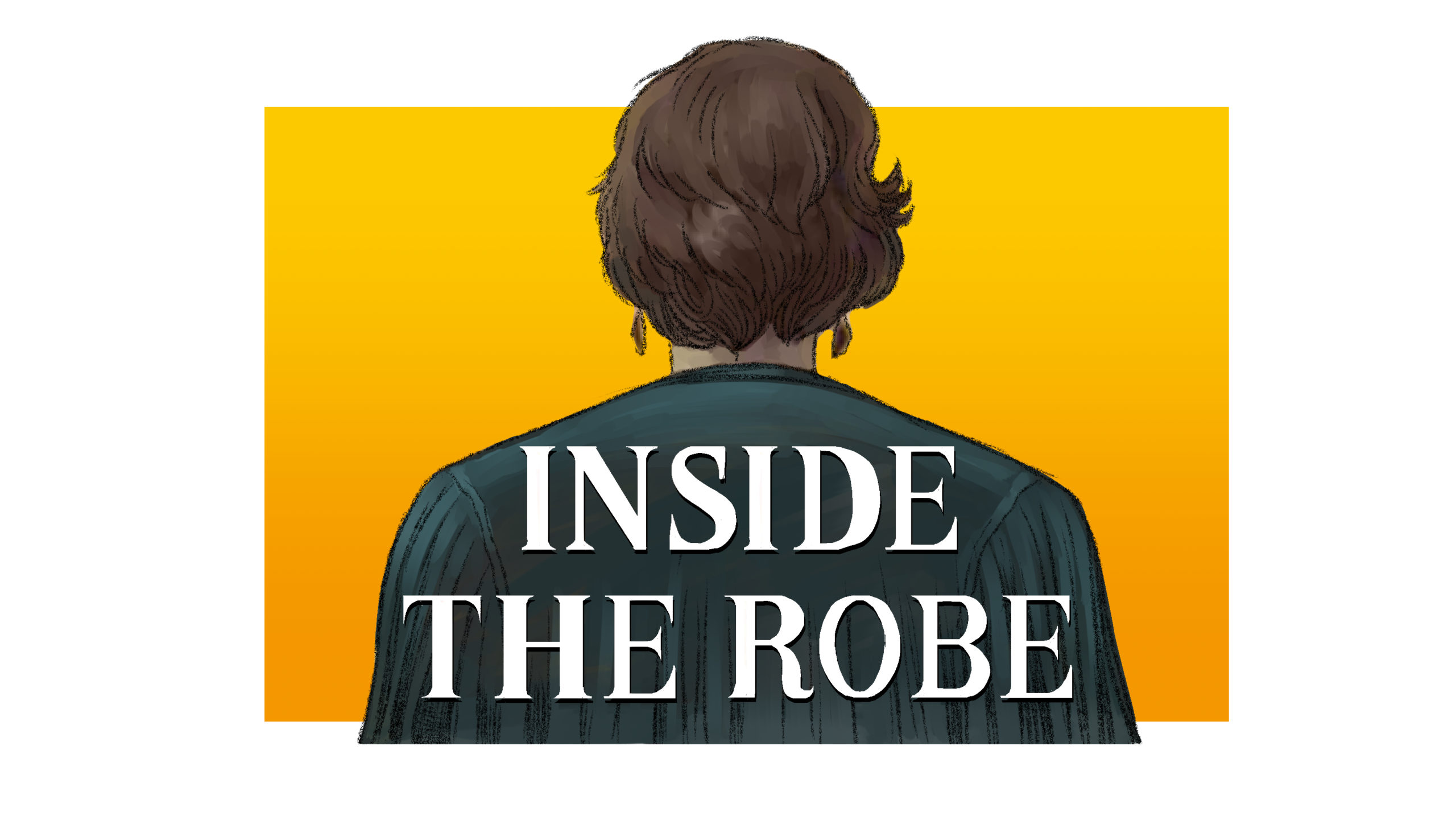In Part 76, Judge Mader reflects on the emotions generated by being ‘disqualified’ from a case, and then offers her philosophy about the amount of detail a judge owes the court when ruling.
You can find links to all installments of Inside the Robe here.
September 13
The jury in my latest trial finally returned with a split verdict. The defendant was convicted of robbery for taking the small items from the Rite-Aid and pushing the loss-prevention officer as she tried to prevent him from running outside, as well as battering the Good Samaritan who was ultimately hit by a car. However, the jury did not convict the defendant of misdemeanor sexual battery.
The entire sequence of events was bizarre. Crimes are commonly seen in combination. For example, a robber might steal a car escaping from a robbery. A robber might assault strangers in his hurry to get away. A robber might drive away from the scene of the crime at a high speed and try to evade the police. In this case, the prosecution claimed the robber, who was hastily running from the Rite-Aid, stopped in plain sight of several witnesses to assault a woman and try to pull down her pants. I have never seen this combination of crimes. It doesn’t make sense.
The defense attorney made an impassioned argument, writing in big letters on her PowerPoint, “Maria L. is a Liar.” The prosecutor got up in her rebuttal argument and argued indignantly: “Can you believe what the defense just argued? That a crime victim who was obviously suffering from the assault just made it all up? She even has the nerve to call her a liar? What possible motive could the woman have for making up that she was sexually assaulted? Do you think that someone would make up a story, take an oath to tell the truth, agree to be cross-examined thoroughly on the witness stand, and have it all be a lie? What can this woman get out of it?”
A prosecutor with whom I thought I had a good relationship disqualified me on an attempted murder trial that came from my court and was going to be sent back for trial. I feel irritated. This same prosecutor conducted a stress-free trial here several weeks ago. Why did he disqualify me now? I will probably never know. He will return to my court on other cases and appear pleasant to my face. And I will be pleasant in return.
September 14
I am still stewing over the prosecutor who disqualified me yesterday. I thought we got along well. It’s similar to dating stories I’ve heard about successful first dates. The conversation flowed easily; both parties didn’t want the evening to end. They part with the guy ardently promising, “I’ll give you a call in the morning. We need to see each other soon.”
The woman waits and hears nothing. She even texts her date but doesn’t get a return text. She’s been ghosted and never hears from him again. What happened? She will never find out. And neither will I. A myriad of things might have happened with the trial prosecutor sent to my court. He could have wanted to bring his trial to my court. His supervisor might have ordered him to disqualify me. Regardless of the possibilities, it feels personal and feels like rejection. I wonder what “I did” to deserve being rejected. The dating girls, as well as I, shouldn’t blame ourselves, yet we do.
Another judge this morning told me of a similar experience. Despite a lengthy series of pre-trial hearings in which he ruled in favor of the prosecution on every issue, the prosecutor disqualified him when the trial was sent to his court. The judge tried to analyze what he did or said. He thought, “Perhaps the prosecutor was annoyed that I gave the same attention to the defense attorney’s stupid arguments as I did to the prosecution’s more sensible arguments.” It is impossible to know why a decision is made to disqualify a judge, but we will always speculate.
One issue that judges also second-guess is how much or little they should explain their decisions in court. The public jokes that a judge’s job is easy. “All you have to do is sit there and say ‘granted’ or ‘denied.’”
It’s not that simple. In the beginning, I thought that the attorneys, defendant, and audience expected me to explain in detail my reasoning for every decision. I prepared extensive notes and case authority every time I ruled. I often interrupted attorneys to point out case law they overlooked. I ended up feeling defensive and argumentative, always trying to persuade both sides that my approach was the only correct one. No one was ever persuaded, and everyone left the hearing frustrated.
Next, I switched to a truncated approach. I listened to the arguments without saying anything, just turning my head side to side as though I was watching a tennis match. At the end, I made a pronouncement: “Denied” or “Granted.” No further explanation. This technique didn’t work well either. It sometimes worked with timid attorneys who just went away. The more assertive attorneys, however, tried to push me into explaining legal bases for my rulings. Just replying, “I’ve ruled, counselor. Move on, please” didn’t cut it.
Attorneys on both sides were dissatisfied because they didn’t have a clue what I was thinking. While a judge has no duty to explain a ruling, it must be unsatisfying for an attorney to put time and research into a case and not know whether anything he said or did was persuasive. Terse rulings create belligerent and bullying attorneys demanding explanations. All parties go away upset.
A middle ground came later. Realizing that higher courts are more likely to agree with my rulings if I give them signposts, I try to figure out what issues will interest a higher court and make sure those issues are fully explained.
I don’t want to sound like an old windbag on the bench explaining my rulings. But I also don’t want to come across as a cipher. Like former Fed chairman Alan Greenspan explaining whether interest rates will go up or down, no one can make me say more or less. It is my courtroom and I am “Da Judge.” This is a balancing act that comes with time, and, after fifteen years, I’m getting the hang of it.
September 15
A criminal threats jury trial arrived, and results will be of no consequence. The defendant is charged with making a criminal threat to attack a sheriff’s deputy in the courthouse. The case is meaningless because the defendant was convicted last month of murder and is awaiting his sentence of fifty years to life in another courtroom.
I tried to reason with him. “Going to trial in this case makes no sense. If you plead ‘no contest,’ I will run your thirty-two-month sentence at the same time as the murder sentence. That means you won’t get any extra time. You’ve even got two other criminal threat trials pending in another courthouse. If you’re convicted here, I could run your sentence consecutive to the murder. And you’d have even more time.” The defendant, a twenty-five-year-old with a shaved head and a nasty expression, is standing on principle and insisting on his trial.
He has been a constant threat to sheriff’s deputies guarding the jail. With a hair-trigger temper, he is often sent to “the hole,” a solitary jail disciplinary cell with no access to other inmates, even less- desirable food, and no TV or other distractions. The defendant doesn’t seem to mind. He has been found several times with jail-made weapons known as shanks, ingeniously constructed from sharpened portions of table legs or bed frames. This defendant will use any item as a shank, even a plastic asthma inhaler. Connecting together toothbrushes, he constructs shank handles, and is a nightmare to guard.
I ruled he should be kept in a stealth belt during the trial for safety reasons. The belt sounds worse than it is. The defendant remains in his chair with his shirt untucked. Around his waist is a tightly woven white, cloth, karate-style belt. The hook on the back of the belt attaches to a metal ring in the crease of the inmate’s chair where the backrest meets the seat. It is impossible for a defendant in a stealth belt to attack trial participants or try to escape without the chair coming up with him. As the belt is hidden under the defendant’s untucked shirt, it’s invisible to jurors.
Years ago, criminal threats were named “terrorist threats” by the state legislature. Jurors always looked startled when told that a defendant is charged with a terrorist threat and calm down once they found out that the common use of the word terrorist had nothing to do with the facts in the case. Fortunately, the crime has been recently re-labeled “criminal threat.”
At the end of the day, a material witness in another murder case pending in my court was brought before me by a prosecutor. A material witness is someone an attorney demonstrates is essential to their side of the case who is resisting coming to court and testifying. At the prosecutor’s request, I recently issued an arrest warrant for this witness and set a bail of $100,000. The prosecutor provided a declaration under penalty of perjury that the witness was avoiding service of the subpoena, was never at his listed addresses, and told the investigating officer on the phone that he would not show up in court.
A private attorney accompanied the police officer and the angry witness. As he came in through the front door of the courtroom in handcuffs, the lawyer argued that the witness should simply be ordered back to court and he “would definitely return.” I tried to ask the witness specific questions. “Why were you avoiding the person trying to serve you with a subpoena? Where have you been?” The witness kept telling me, “I’m not avoiding coming to court. I’m in the ‘hospitality business.’ I supply limousines for celebrity rappers around the country. Lots of times I’ve been out of state delivering cars.”
Instead of holding a reluctant witness in custody pending his testimony at the trial, I set bail at $50,000. Our trial was at least six weeks away. No coincidence, a bail bondsman was waiting in the audience, expecting that I would set bail, and he was prepared to write the bail bond on the spot, so the witness could leave the courtroom uncuffed through the same front door he entered.



